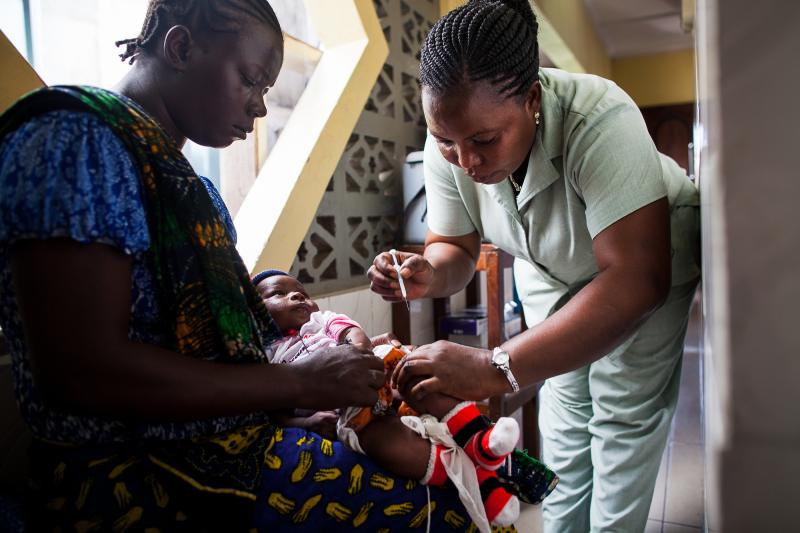Where We Work
See our interactive map


Photograph by Trevor Snapp for IntraHealth International
In Tanzania, interoperability is working behind the scenes to bring vaccines to more babies that need them.
I used to tell colleagues I was better at discussing the benefits of breastfeeding and handwashing than health information systems.
I have a background in natural childbirth instruction and community-based development, and when I started working in digital health a few years ago, I missed the human aspects of global health. I had a shiny new master’s degree in public health but felt lost in the conversations about canonical data models and reference implementations.
Where were the babies? Where were their mamas? Did all this talk about enterprise-level architecture make a discernable difference in their lives? Why did it matter?
The answer—I came to find out—is in harnessing the power of data exchange through interoperable systems.
Did all this talk about enterprise-level architecture make a discernable difference in their lives? Why did it matter?
In digital health, the term interoperability refers to the ability of different information systems and software applications to communicate and exchange data. The more sources from which data are collected, the better health workers and policy-makers can detect patterns and trends in the health of a population and plan programs and interventions accordingly.
Suppose a system containing information on health workers, like iHRIS, tells us that there are four midwives working at a particular clinic, and another system, like DHIS 2, collects service delivery statistics and tells us that only 40 babies are born at that same clinic each year.
Separately, the valuable information these two platforms provide might not inform policy. But if the systems were interoperable, health officials could run a staffing analysis report that would likely indicate that some of these midwives would be better utilized in another clinic where there’s a higher volume of births.
This is just one small example of how data from interoperable systems can make health systems operate more efficiently—and lead to better care for babies and their mamas.
This is the driver behind the Tanzania Better Immunization Data (BID) Initiative, which is based on the belief that better data plus better decisions will lead to better health outcomes. Funded by the Bill & Melinda Gates Foundation, the vision behind the BID Initiative is to empower countries to enhance immunization and overall health service delivery through improved data collection, quality, and use.
IntraHealth International worked on a core component of the BID Initiative in Tanzania—the back-end development that ensures immunization data is shared, offering end-to-end visibility into the vaccine supply chain from individual facilities all the way to the national level.
When babies are vaccinated, data on vaccines is shared throughout the system.
When a mother takes her baby to get his six-week vaccinations, a nurse at the health center can find his record in Tanzania’s immunization registry. After locating it, the nurse enters the names of the vaccinations the baby has received and saves them to his record. Each week individual counts of vaccines given to babies in BID-supported regions of the country, as well as stock levels of those same vaccines, are pulled from the immunization registry and pushed into the vaccination information management system, which then pushes the information into the national district health information system (DHIS2). Together, these three interoperable systems comprise Tanzania’s Electronic Immunization System.
This means that when a district immunization and vaccine officer (DIVO) working in the vaccination information system notices that the stock of an essential vaccine is low in a high-volume facility, the officer can quickly request a distribution in the vaccination information system so that more of the antigen can be delivered to the facility, averting what might otherwise result in a dangerous stock out. Interoperability through the Electronic Immunization System not only allows this request to be registered in the vaccine immunization management system, but it also sends a notification to the immunization registry that more stock is on its way.
This exchange of data, always running behind the scenes, lessens the possibility of a mother arriving at a facility and being met with the unfortunate news that the vaccinations she has come for are out of stock. This, in turn, lessens the possibility of that mother having to make another trip with her baby and, more importantly, it lessens the possibility that her baby will go unvaccinated.
Turns out that interoperability is, in fact, able to make a difference in the lives of moms and their babies.
IntraHealth’s worked on the Tanzania BID Initiative between December 2014 and May 2018 with funding from the Bill & Melinda Gates Foundation. The work of the BID project will be highlighted during the 2018 OpenHIE Community Meeting to be held in Arusha, Tanzania July 31 – August 4, 2018.
Get the latest updates from the blog and eNews




